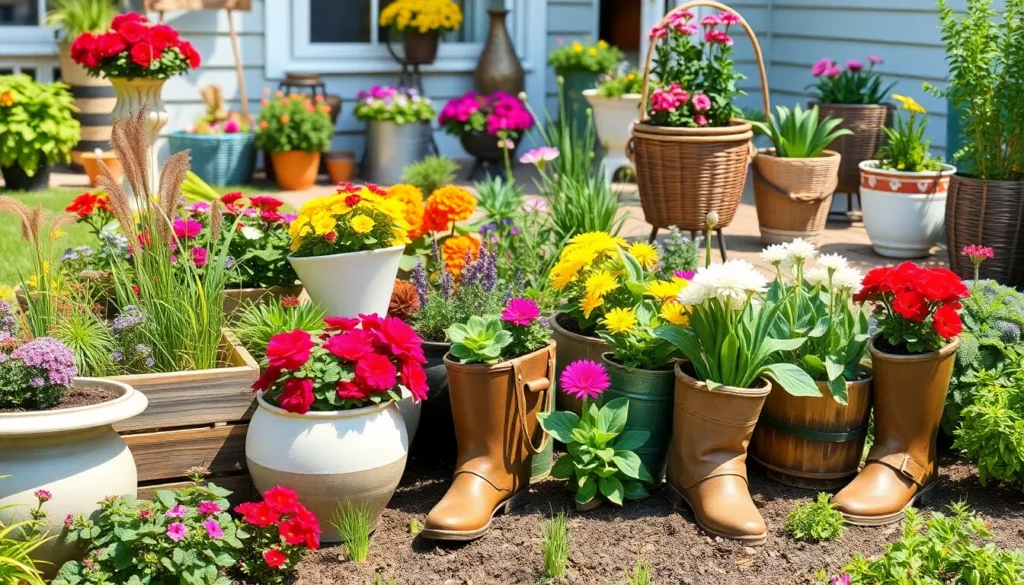We’ve all stared at empty garden spaces wondering how to transform them into something spectacular. Garden planters offer the perfect solution for creating stunning focal points while maximizing your growing potential in any outdoor space.
Whether you’re working with a sprawling backyard or a compact patio, the right planter ideas can revolutionize your gardening game. From DIY wooden boxes to elegant ceramic vessels, we’ll explore creative options that suit every style and budget. These versatile containers don’t just hold plants – they become architectural elements that define your garden’s personality.
Ready to discover how strategic planter placement can create depth, organize your space, and showcase your favorite blooms? We’re diving into innovative ideas that’ll help you design a garden that’s both functional and Instagram-worthy, regardless of your experience level or space constraints.
Repurposed Household Items as Creative Garden Planters
Household items we typically discard can become stunning garden planters with a bit of creativity. These unexpected containers add personality to our outdoor spaces while reducing waste.
Old Boots and Shoes for Whimsical Displays
Transform worn-out footwear into charming miniature gardens that bring smiles to visitors. We recommend using rubber boots like Wellington boots or sturdy hiking boots since they naturally resist weather damage. Drill three to four small drainage holes in the soles before adding potting soil.
Position these quirky planters near garden entrances or along pathways where their playful nature creates conversation starters. Succulents work particularly well in boot planters since they require minimal soil depth. Children’s colorful rain boots make especially delightful containers for small flowers like pansies or marigolds.
Arrange multiple boot planters in clusters to create themed displays throughout the garden. We’ve seen gardeners create entire “shoe gardens” using everything from old sneakers to formal dress shoes.
Vintage Colanders for Perfect Drainage
Use metal colanders as natural drainage systems for plants that despise soggy roots. The built-in holes eliminate the need to drill drainage, making these kitchen castoffs immediately garden-ready. Stainless steel colanders resist rust better than aluminum options in outdoor conditions.
Suspend colanders from shepherd’s hooks or tree branches to create elevated planting displays. Trailing plants like ivy, petunias, or cherry tomatoes cascade beautifully through the drainage holes. We often line the bottom with coconut fiber to prevent soil from escaping while maintaining proper drainage.
Group colanders of different sizes to establish visual rhythm in garden corners or patio areas. Vintage enamelware colanders add farmhouse charm, while modern stainless steel versions suit contemporary garden designs.
Wooden Crates for Rustic Charm
Repurpose fruit crates and wine boxes into substantial planters that accommodate larger plants and vegetables. We recommend treating untreated wood with food-safe sealant to extend outdoor lifespan. Apple crates and wine boxes typically measure 12-18 inches in depth, providing adequate root space for herbs and small vegetables.
Stack wooden crates vertically to create tiered planting systems that maximize growing space in compact areas. This arrangement works exceptionally well for herb gardens where we need easy access to basil, oregano, and thyme. Line each crate with industry fabric to prevent soil spillage while allowing drainage.
Customize crate planters with stenciled numbers or garden labels to organize plantings by variety or harvest timing. We often see gardeners paint crates in coordinating colors to match their home’s exterior palette.
DIY Wooden Planter Ideas for Garden Enhancement
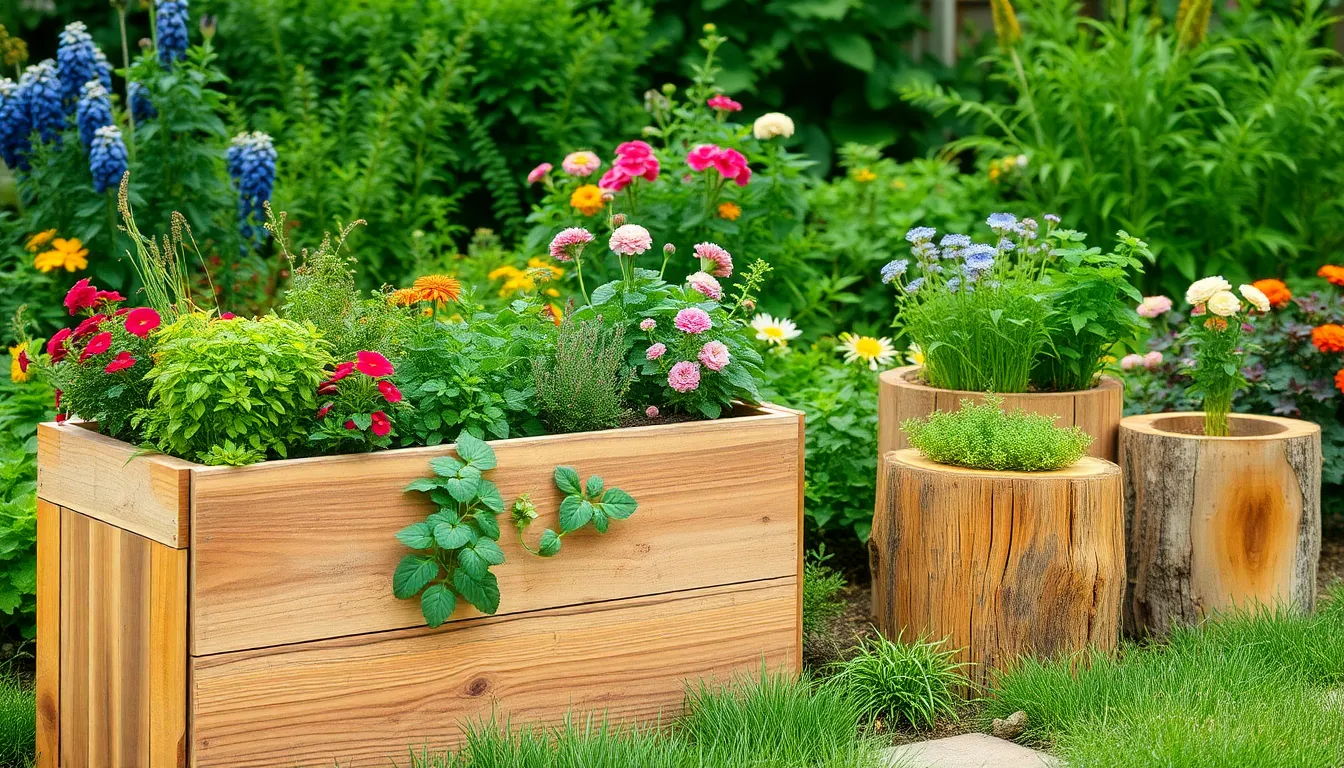
Wooden planters offer exceptional durability and natural beauty that complements any garden design. We’ll explore three outstanding options that combine functionality with aesthetic appeal.
Cedar Box Planters for Longevity
Cedar box planters stand out as our top recommendation for gardeners seeking long-lasting wooden containers. This premium wood naturally resists rot and insects without requiring chemical treatments, making it perfect for vegetable gardens and herb displays.
Building cedar planters typically involves using 1×4 and 1×2 cedar boards to create sturdy frames that withstand years of outdoor exposure. We recommend constructing these planters with reinforced corners and proper drainage holes to maximize their lifespan. Cedar’s natural oils repel moisture and pests while developing a beautiful silver-gray patina over time.
These planters work exceptionally well for raised bed gardens, container gardening on patios, and creating defined growing spaces in larger landscapes. Cedar’s lightweight nature makes these planters easy to relocate when needed, while their natural insulation properties protect plant roots from temperature fluctuations.
Pallet Wood Raised Bed Planters
Pallet wood raised bed planters offer an eco-friendly solution that transforms discarded shipping materials into functional garden containers. Reclaimed pallet wood provides a cost-effective alternative to purchasing new lumber while reducing waste and adding rustic character to outdoor spaces.
We suggest selecting heat-treated pallets (marked with “HT”) rather than chemically treated ones to ensure plant safety. Dismantling pallets carefully preserves usable boards that can be reassembled into custom-sized raised beds. These planters typically feature a weathered appearance that develops natural character as they age.
Creating pallet planters involves reinforcing joints with additional screws and adding industry fabric to prevent soil spillage. We find these planters particularly suitable for vegetable gardens, herb collections, and flower displays where a farmhouse aesthetic is desired.
Tree Stump Natural Planters
Tree stump natural planters transform what would otherwise be yard waste into unique garden focal points. Hollowed-out tree stumps serve as distinctive containers that blend seamlessly with natural landscapes while providing excellent growing conditions for various plants.
We recommend selecting stumps from hardwood trees like oak or maple for their superior durability and attractive grain patterns. Creating these planters involves careful hollowing to maintain structural integrity while providing adequate soil depth. Natural drainage occurs through the wood’s porous structure, though additional holes may be necessary for optimal water management.
These organic planters excel at showcasing small plants, herbs, succulents, and seasonal flowers that benefit from the natural insulation properties of wood. Tree stump planters work particularly well in woodland gardens, cottage-style landscapes, and areas where you want to maintain a natural, undisturbed appearance.
Vertical Planter Solutions for Small Garden Spaces
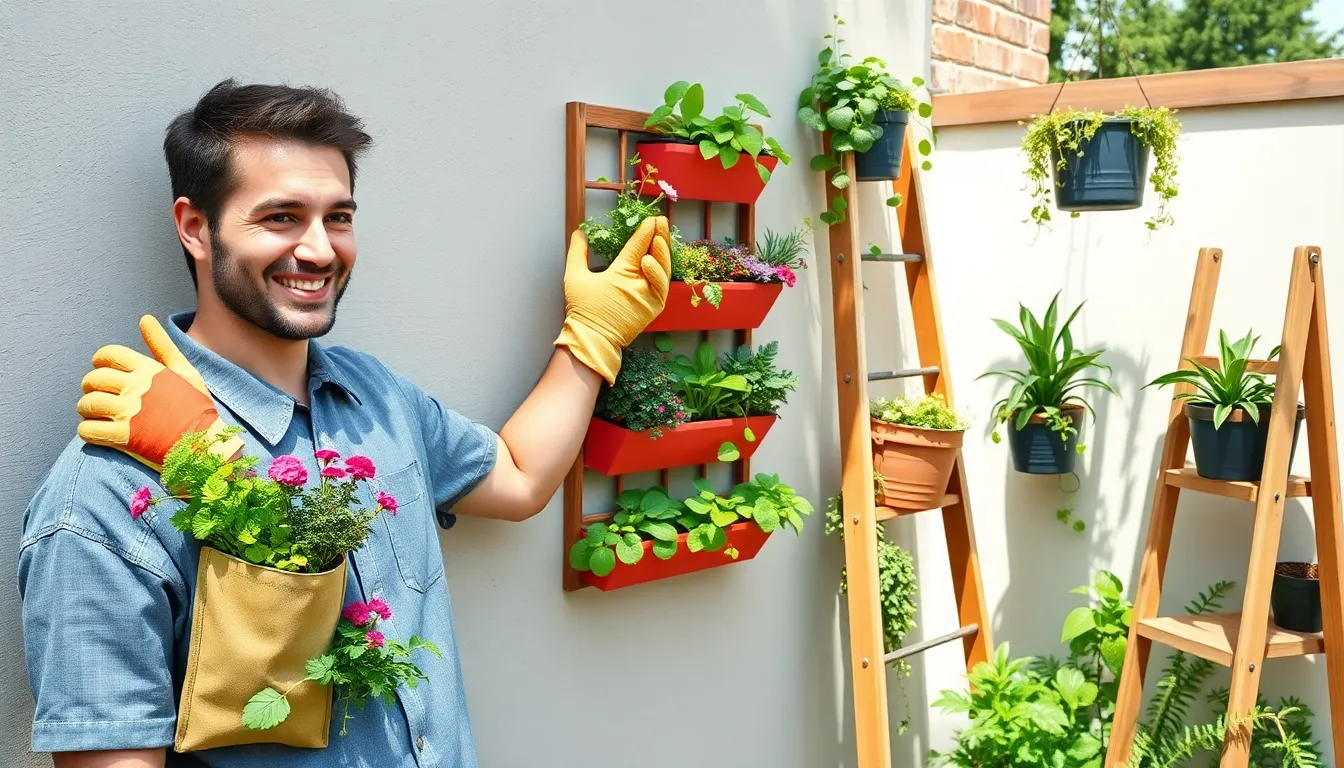
Maximizing garden potential becomes achievable when we use vertical surfaces to create stunning planting displays. These space-saving answers transform walls, fences, and unused vertical areas into thriving gardens perfect for compact spaces.
Wall-Mounted Pocket Planters
Wall-mounted pocket planters offer lightweight fabric or plastic pockets that attach easily to walls or fences for versatile planting options. We can install these systems quickly and reposition them as our garden needs change throughout the seasons.
These planters work exceptionally well for herbs like basil and oregano, succulents such as echeveria and jade plants, and small flowers including pansies and petunias. Installation requires minimal tools, and the flexible design allows us to adjust plant placement for optimal sunlight exposure.
Maintenance becomes more frequent with wall-mounted systems since they require regular watering due to increased air circulation. But, this trade-off provides unmatched flexibility for creating custom arrangements that maximize our available vertical space.
Ladder Shelf Planter Systems
Ladder shelf planter systems use wooden or metal ladders fitted with platforms or hanging pots to create tiered planting areas within compact footprints. We can repurpose old ladders or purchase purpose-built systems that provide multiple levels for plant display.
These systems excel at accommodating various plant sizes, from small herbs on upper rungs to larger vegetables and flowers on lower shelves. Wooden ladders offer rustic charm while metal versions provide durability and modern aesthetics for contemporary garden designs.
Positioning becomes crucial for ladder planters since we need to ensure each tier receives adequate sunlight without upper plants shading lower ones. The tiered arrangement creates visual interest while maximizing our planting capacity in minimal floor space.
Hanging Tiered Garden Planters
Hanging tiered garden planters create cascading arrangements using stackable plastic or ceramic pots that make efficient use of vertical space on balconies or patios. Systems like the GreenStalk feature integrated watering mechanisms that reduce labor and minimize water waste through efficient distribution.
We can arrange these planters to showcase trailing flowers such as petunias and lobelia, or small vegetables like cherry tomatoes and lettuce varieties. The cascading effect produces stunning visual displays while keeping plants organized and easily accessible for harvesting.
Stackable designs allow us to customize height and plant capacity based on our exact space constraints and gardening goals. These systems prove ideal for renters or anyone seeking portable vertical gardening answers that don’t require permanent installation.
Decorative Container Ideas for Stylish Garden Planters
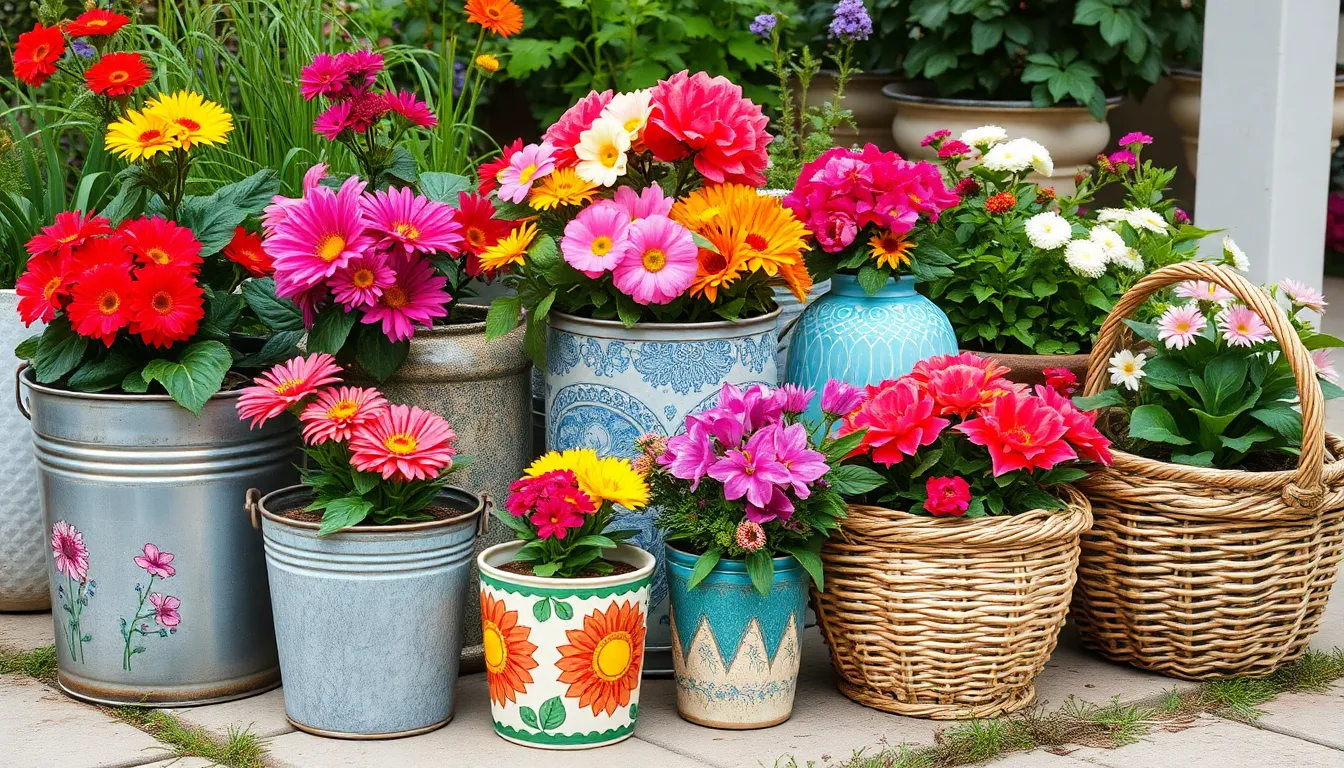
Building on our previous planter answers, we’re now exploring decorative containers that combine functionality with striking visual appeal. These stylish options transform ordinary garden planters into statement pieces that elevate any outdoor space.
Galvanized Metal Buckets and Tubs
Galvanized metal containers bring a modern industrial aesthetic to garden spaces while delivering exceptional durability against weather elements. We find these buckets and tubs at home stores and online retailers for surprisingly affordable prices, making them accessible for most gardening budgets.
Weather resistance sets galvanized metal apart from other container materials, as these planters withstand harsh outdoor conditions without rusting or deteriorating. The soft gray surface creates an attractive contrast against vibrant flowers like petunias and marigolds or lush greenery such as ferns and hostas.
Aging characteristics add to their appeal over time, as regular watering gradually develops a rustic, weathered appearance that enhances the industrial charm. We recommend grouping different sized galvanized containers to create ever-changing visual arrangements that work well with both modern and farmhouse garden styles.
Ceramic Pots with Artistic Designs
Ceramic planters offer the widest range of decorative possibilities with their diverse shapes, sizes, and artistic finishes available in today’s market. These containers come in various colors and patterns, allowing us to match or complement existing outdoor décor seamlessly.
Geometric styles work particularly well as focal points in contemporary garden designs, while highly decorative patterns suit traditional or eclectic outdoor spaces. Concrete and glazed ceramic pots enhance outdoor environments by adding sophisticated texture and visual interest to planting arrangements.
Grouping strategies maximize ceramic planters’ impact when we cluster them in odd numbers or varying heights to create visual harmony throughout the garden. We’ve found that ceramic containers work exceptionally well for showcasing specimen plants like ornamental grasses or flowering shrubs that benefit from elegant presentation.
Wicker Basket Planters with Liners
Wicker basket planters provide a natural, earthy aesthetic that bridges indoor and outdoor gardening styles with traditional versatility. These lightweight containers make seasonal rearrangements effortless, whether we’re moving them to follow sunlight patterns or creating fresh displays for different occasions.
Waterproof liners are essential for protecting wicker from moisture damage while preventing soil from leaking through the basket weave. We recommend using coconut fiber liners for natural appeal or plastic liners for maximum water protection in outdoor applications.
Placement flexibility allows wicker planters to work equally well indoors during harsh weather or outdoors in sheltered spaces like covered porches and gazebos. These baskets complement cottage garden styles beautifully when filled with cascading plants like trailing petunias or ivy, creating soft textural contrasts in garden compositions.
Recycled Material Planters for Eco-Friendly Gardens
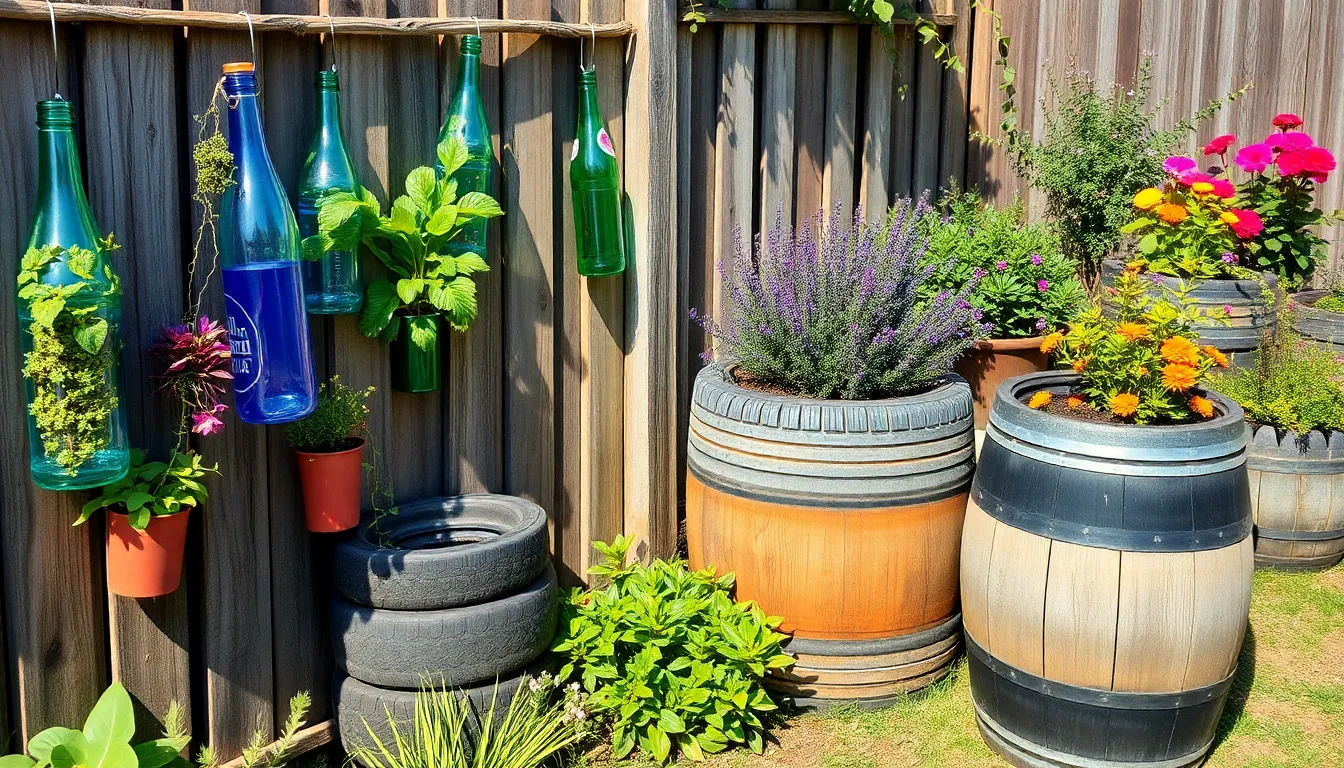
Eco-friendly planters made from recycled materials help reduce waste while creating stunning focal points throughout your outdoor space. These sustainable options transform everyday discarded items into functional garden containers that support environmental consciousness without sacrificing style.
Plastic Bottle Hanging Planters
Clean plastic bottles make excellent zero-cost hanging planters for small spaces and vertical gardens. We recommend cutting openings in 2-liter bottles and adding drainage holes at the bottom to prevent waterlogging. String or wire hangers allow these lightweight containers to be suspended from fences, patios, or balcony railings with minimal structural support.
Fill these repurposed containers with potting soil to create perfect homes for herbs, flowers, or small decorative plants. YouTube tutorials demonstrate step-by-step instructions for various cutting techniques and hanging methods. This DIY approach keeps post-consumer plastic waste out of landfills while creating vibrant green displays in previously unused vertical spaces.
Tire Planters for Large Plants
Old tires provide weather-resistant containers that can accommodate large plants and shrubs with extensive root systems. We suggest stacking multiple tires vertically to create tiered arrangements or using single tires as standalone planters for individual specimens. Painting tires with outdoor-grade paint adds color coordination and helps blend these recycled containers into existing garden aesthetics.
Arrange tires horizontally or vertically depending on your space requirements and plant selection. This method recycles rubber materials that are otherwise difficult to dispose of responsibly while providing ample growing space. Tire planters excel in outdoor environments and can be easily moved or rearranged as garden layouts evolve.
Wine Barrel Half Planters
Half wine barrels offer rustic charm combined with large capacity storage for shrubs, small trees, or mixed planting arrangements. We find these repurposed containers naturally resistant to rot and exceptionally sturdy for long-term outdoor use. Their wooden construction provides excellent insulation for plant roots while contributing decorative character to gardens and patios.
These sustainable containers use barrels that have reached the end of their wine-producing lifecycle. Built-in drainage capabilities and generous interior space make wine barrel planters suitable for diverse plant species. Their classic appearance complements both traditional and contemporary garden designs while supporting eco-friendly gardening practices.
Seasonal Planter Ideas for Year-Round Garden Interest
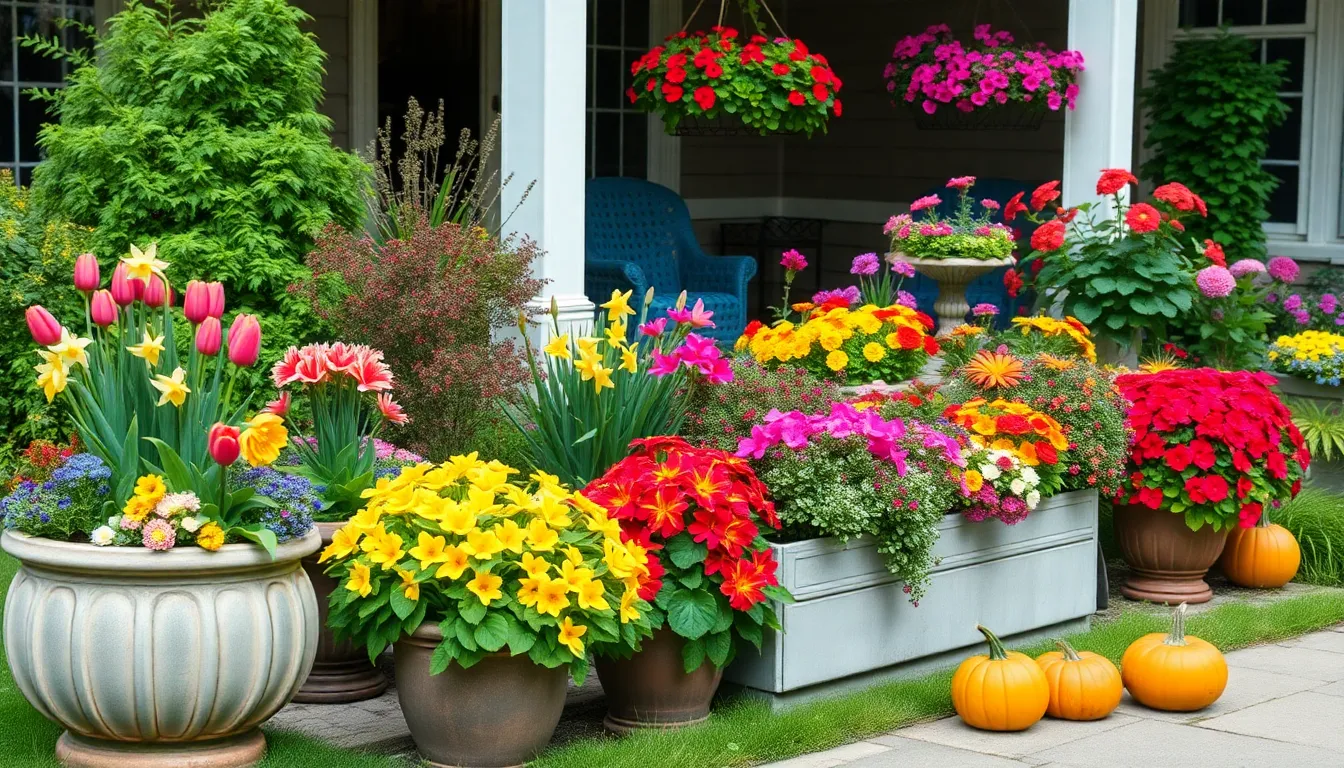
We’ll keep our gardens vibrant throughout every season by strategically planning planter arrangements that transition beautifully from spring to winter.
Spring Bulb Display Planters
Early bloomers transform empty winter containers into spectacular spring showcases. Tulips, daffodils, and hyacinths create vibrant displays that announce winter’s end with bold colors and fresh fragrances. Plant these bulbs in fall for stunning early spring results that’ll brighten even the gloomiest March days.
Perennials and evergreens provide the perfect backdrop for seasonal bulb displays. Combine spring bulbs with evergreen shrubs like boxwood or rosemary to create layered arrangements that offer structure beyond the blooming period. This approach ensures our planters maintain visual interest even after bulb flowers fade.
Pansies and lamium extend the color show before and after bulbs reach their peak. These hardy plants bridge the gap between seasons, providing continuous blooms that complement spring bulbs perfectly. Their compact growth habits make them ideal companions in mixed spring containers.
Summer Annual Flower Combinations
Tropical themes bring vacation vibes directly to our outdoor spaces during peak growing season. Incorporate plants like hibiscus, lantana, and coleus to create vibrant summer displays that thrive in heat and humidity. These bold performers deliver non-stop color from June through September.
Herbs and flowers create functional beauty in summer planter arrangements. Combine rosemary, salvias, and geraniums for fragrant and colorful combinations that serve double duty as cooking ingredients and visual attractions. This practical approach maximizes both aesthetic appeal and garden productivity.
Evergreen backbones provide structure and continuity in seasonal summer planters. Use evergreen plants like ‘Golden Sword’ yucca or ‘Sunshine’ Ligustrum as architectural elements that anchor colorful annual displays. These permanent features ensure our containers look intentional rather than haphazard throughout the growing season.
Fall Harvest Decorative Planters
Seasonal foliage creates stunning autumn displays that celebrate the changing season. Include plants like asters, chrysanthemums, and sedums to capture fall’s natural color palette in our container gardens. These hardy perennials provide rich purples, golden yellows, and deep burgundies that mirror autumn landscapes.
Harvest themes incorporate decorative elements that celebrate fall’s abundance. Add pumpkins, gourds, and colorful fall leaves to create displays that capture the season’s festive spirit. These natural accessories complement planted arrangements while adding texture and seasonal character.
Red and yellow twig dogwoods provide striking winter interest after fall flowers fade. Use these shrubs for their colorful stems that’ll continue providing visual appeal through the coldest months. Their bright bark creates dramatic focal points that bridge fall displays into winter arrangements.
Modern and Contemporary Planter Designs

Modern planters offer sleek designs that transform outdoor spaces into sophisticated landscapes. We’re seeing contemporary styles become increasingly popular for their ability to create stunning focal points.
Geometric Concrete Planters
Geometric concrete planters bring angular sophistication to contemporary garden designs. These modern containers feature sharp lines and bold shapes that create visual interest in any outdoor setting. Angular patterns and geometric forms make these planters ideal for contemporary architectural styles.
Contemporary designers often use these concrete vessels to establish focal points in minimalist landscapes. Bold geometric shapes like hexagons, triangles, and cubes can complement both traditional and modern plantings. Pairing these structured containers with soft, flowing plants creates an appealing contrast that enhances the overall aesthetic.
Weather resistance makes concrete planters particularly valuable for year-round garden displays. Durable construction ensures these containers withstand harsh conditions while maintaining their sharp, defined edges.
Sleek Fiberglass Container Options
Sleek fiberglass planters provide lightweight durability without sacrificing visual appeal. These versatile containers can mimic expensive materials like stone or metal while offering superior portability. Modern manufacturing techniques allow fiberglass planters to achieve sophisticated finishes that rival traditional materials.
Maintenance requirements for fiberglass containers remain minimal compared to other planter materials. Easy cleaning and weather resistance make these planters practical choices for busy gardeners. Lightweight construction allows for seasonal rearrangement without heavy lifting.
Mimicking natural textures, high-quality fiberglass planters can replicate wood grain, stone surfaces, or metal finishes. Cost effectiveness makes these containers accessible options for achieving premium looks on modest budgets.
Minimalist Metal Planter Boxes
Minimalist metal planter boxes deliver clean lines and industrial sophistication to modern gardens. Aluminum and steel construction provides exceptional durability while maintaining sleek profiles. Powder coating options extend the lifespan of metal planters while offering color customization.
Industrial aesthetics appeal to gardeners seeking contemporary outdoor designs. Simple rectangular forms and smooth surfaces create uncluttered visual statements that complement modern architecture. Clean geometry allows plantings to become the primary visual focus.
Versatile sizing options make metal planters suitable for both large industry installations and compact urban spaces. Long rectangular forms work particularly well for creating defined planting beds or property borders. Square configurations provide excellent options for specimen plantings or seasonal displays.
Budget-Friendly Planter Ideas for Garden Makeovers
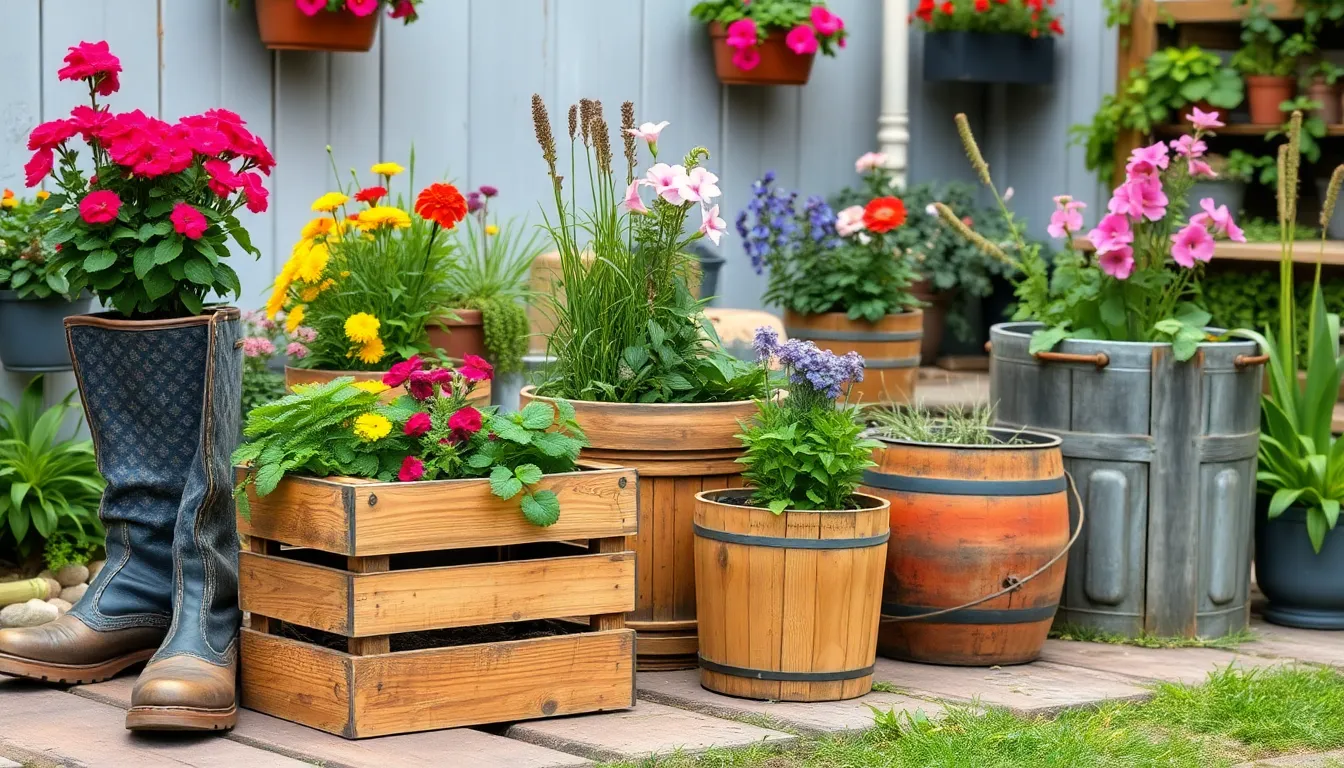
Transform your outdoor space without very costly by discovering creative planter answers that cost a fraction of traditional containers. We’ll show you how to create stunning garden displays using affordable materials and clever repurposing techniques.
Thrift Store Find Transformations
Visit thrift stores regularly to uncover unique containers that can become extraordinary planters for your garden. Old boots make whimsical focal points when filled with cascading flowers or trailing herbs. Wooden crates offer rustic charm and can be arranged at different heights to create visual interest throughout your outdoor space.
Vintage buckets transform into industrial style planters that complement modern garden designs perfectly. Search for items with interesting textures or patinas that add character to your planting displays. Metal containers work particularly well for larger plants that need substantial root space.
Transform discarded household items into conversation starting planters by thinking creatively about their potential. Large ceramic bowls can house succulent arrangements while old colanders provide excellent drainage for herbs. Stack wooden boxes to create tiered planting systems that maximize vertical growing space.
Free Materials from Nature
Gather natural rocks from your property or nearby areas to create stunning stone planters that blend seamlessly with industry designs. Hollow out larger rocks using basic tools to form unique containers for small plants or succulents. Stack smaller stones to build rustic planter walls that define garden borders while housing your favorite flowers.
Bamboo segments make excellent containers for herbs and small flowering plants when you have access to this fast growing material. Cut bamboo between nodes to create natural tubes that provide proper drainage and attractive organic textures. These lightweight planters work perfectly for temporary displays or seasonal arrangements.
Collect fallen branches and logs to construct natural raised bed planters that cost absolutely nothing but your time. Large tree stumps become instant planters when you hollow out the center and add drainage holes. Driftwood pieces can be arranged to form unique container shapes that showcase your creativity.
Simple Paint Makeover Projects
Give old terracotta pots new life by applying bright colors or creative patterns that match your garden’s aesthetic. We recommend using exterior paint that withstands weather elements while maintaining vibrant colors throughout growing seasons. Stenciled designs or hand painted motifs can transform plain containers into artistic focal points.
Add mosaic tiles or colorful pebbles to existing planters for stunning decorative touches that catch sunlight beautifully. This technique works especially well on larger containers where you have ample surface area for creative expression. Use waterproof adhesive and grout to ensure your artistic additions last through multiple seasons.
Create cohesive garden themes by painting multiple containers in coordinating colors that complement your plant choices. Chalk paint offers excellent coverage and distressed finishes that enhance vintage or farmhouse garden styles. Apply protective sealers over painted surfaces to prevent chipping and fading from outdoor exposure.
Conclusion
We’ve explored countless ways to transform your garden with creative planter answers that fit every style and budget. From repurposed household items to sleek contemporary designs each option offers unique opportunities to express your gardening personality.
The beauty of garden planters lies in their versatility – whether you’re working with a sprawling backyard or a compact balcony these ideas help maximize your growing potential. Remember that the best planters combine functionality with visual appeal creating outdoor spaces that truly reflect your personal taste.
Start with one or two planter projects that excite you most and gradually build your collection. Your garden transformation awaits and we’re confident these ideas will inspire you to create the outdoor oasis you’ve always envisioned.
Frequently Asked Questions
What are the best materials for DIY garden planters?
Cedar wood is highly recommended for its natural rot resistance and durability. Pallet wood offers an eco-friendly option for raised beds, while repurposed materials like old boots, colanders, and wooden crates add unique character. For modern looks, consider concrete, fiberglass, or metal containers that provide longevity and weather resistance.
How can I create planters on a tight budget?
Visit thrift stores for unique containers, repurpose household items like old boots and wooden crates, and transform discarded materials like plastic bottles and tires. Simple paint makeovers can revitalize old terracotta pots. Natural materials like rocks and bamboo create rustic designs at minimal cost while maintaining functionality.
What are the best vertical planter solutions for small spaces?
Wall-mounted pocket planters are lightweight and perfect for herbs and small flowers. Ladder shelf systems create tiered arrangements that maximize planting capacity, while hanging tiered planters offer cascading displays ideal for balconies. These solutions optimize vertical surfaces to create stunning displays in compact areas.
How do I choose plants for seasonal planter arrangements?
Spring planters should feature bulbs like tulips and daffodils with perennials for structure. Summer arrangements work well with tropical plants and herbs. Fall displays can include colorful foliage and decorative pumpkins, while winter planters benefit from evergreens and colorful twig dogwoods for year-round visual interest.
What eco-friendly planter options are available?
Recycled plastic bottles make excellent hanging planters for small spaces. Old tires can be stacked or painted for weather-resistant containers suitable for large plants. Half wine barrels offer rustic, durable options with ample planting space. These materials reduce waste while creating attractive focal points.
How should I arrange planters for maximum visual impact?
Strategic placement creates depth and organization in your garden. Use varying heights and sizes to create visual interest. Group planters in odd numbers, consider color coordination, and place larger containers as focal points. Vertical arrangements help maximize space while maintaining accessibility and aesthetic appeal.

